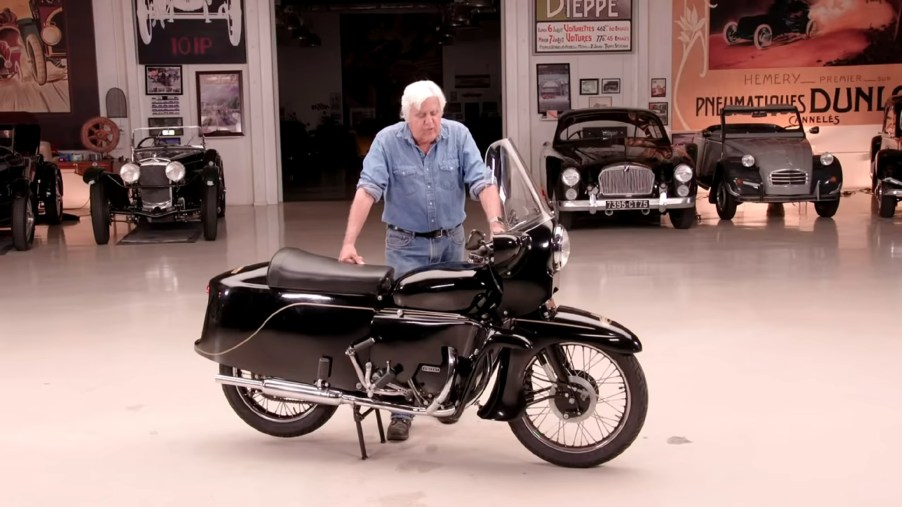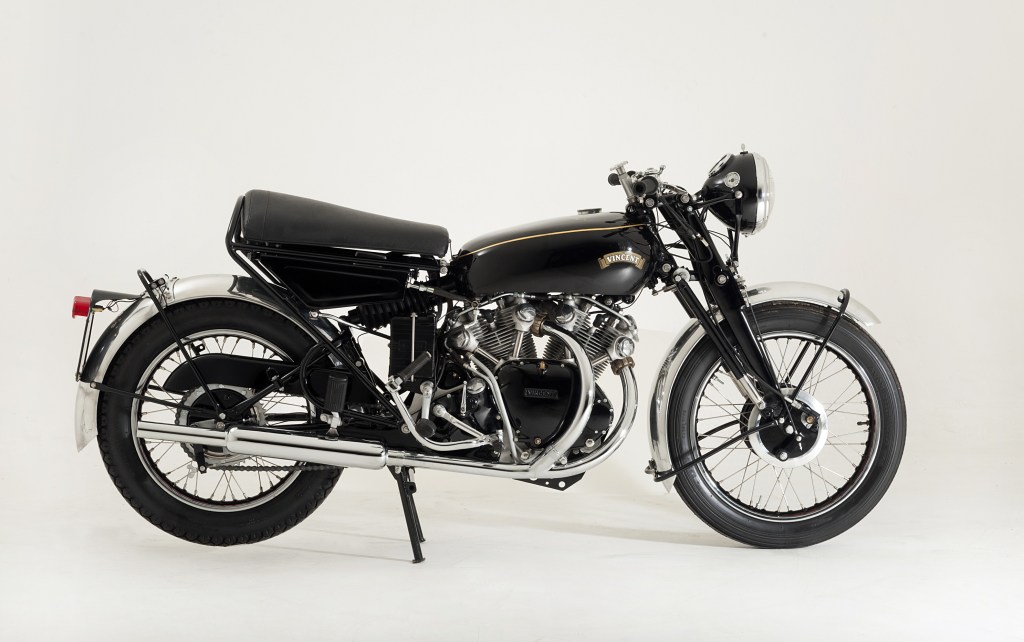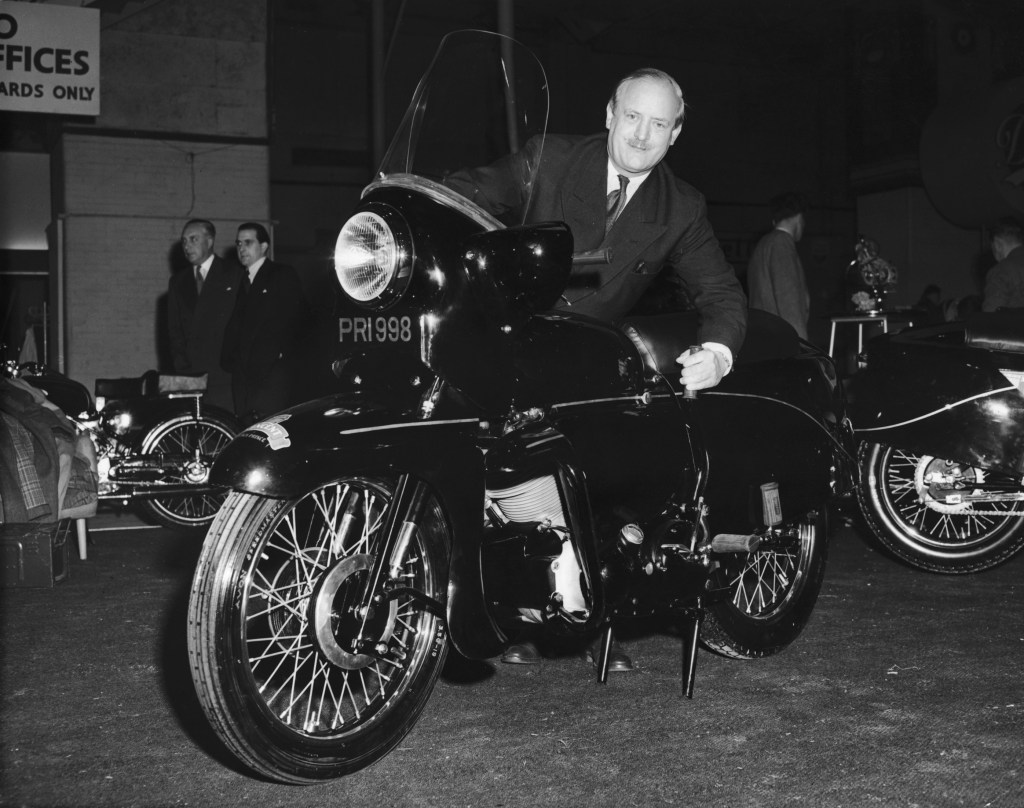
Jay Leno Rides A “Two-Wheeled Bentley”: A Vincent Black Prince
Whether for marketing reasons or as introductions to interested parties, bikes are often compared to well-known car brands. Ducati, for example, is often called ‘the Ferrari of motorcycles.’ And famously, British marque Brough-Superior was dubbed ‘the Rolls-Royce of motorcycles,’ with Rolls-Royce’s blessing no less. So, what does the Bentley of bikes look like? As Jay Leno explains in his latest video, that would be the Vincent Black Prince.
It’s not armored, but the Vincent Black Prince clad the Black Shadow for refined cleanliness

When Kawasaki unleashed the Z1 900, it broke a 25-year-old production motorcycle top-speed record. That record was set by the 125-mph 1948 Vincent Black Shadow, often considered the first ‘true’ superbike. However, the Vincent Black Shadow isn’t a superbike purely because of its speed. With features like cantilever rear suspension, hydraulically-damped girder forks, and a frame that uses the engine as a stressed member, it was incredibly advanced for the period.
Unfortunately, by 1954, though its performance was still super, the rest of the Black Shadow was showing its age, Hagerty explains. And Vincent’s refusal to compromise quality, though admirable, wasn’t helping matters, Silodrome notes. Though neither were changing market taste.
By this point, scooters like the original Vespa, with their air of sleek sophistication, were overtaking motorcycles in popularity. The Honda Super Cub, designed not to let fluids and road grim spoil riders’ clothes, further exacerbated the situation. However, Vincent wasn’t ready to let its Black Shadow slink off quietly into the good night.
Although not an official designation, 1954 marked the ‘Series D’ Black Shadow’s arrival. While it used the same basic Black Shadow engine and chassis design, the Series D had several upgrades and refinements. And it had a new trim with a new fully-enclosed body designed to shield the sophisticated rider from all manner of detritus: the Vincent Black Prince.
Underneath its black fiberglass bodywork, the Vincent Black Prince is a final-series Black Shadow. So, it has the same engine, frame, suspension, etc. as the standard superbike, Mecum explains. But as noted earlier, the Black Shadow had warped a bit by this point.
The Vincent Black Prince had everything a traveling 1950s businessman needed

| 1954-1955 Vincent Black Prince | |
| Engine | 998cc air-cooled V-twin with dual Amal Monobloc carburetors |
| Horsepower | 55 hp |
| Transmission | Four-speed manual |
| Front suspension | ‘Girdraulic’ hydraulically-damped girder forks |
| Rear suspension | Cantilever mono-shock |
| Curb weight | 462 lbs (Mecum) |
| Top speed | 115-120 mph |
Firstly, although it still used drum brakes, the Series D Vincent Black Shadow had a new frame that ditched the ‘upper frame member’ oil tank for a strut. Vincent also upgraded the rear suspension from a dual-shock setup to a spring-and-damper mono-shock, bringing it even closer to a modern swingarm. The bike’s ignition system was upgraded to a coil-and-distributor setup. And to make maintenance easier, Vincent gave it a center stand.
However, because it was designed as a sort of ‘gentleman’s express,’ Vincent gave the Black Prince a few extra goodies. For one, there’s the heavy-duty fiberglass bodywork, fender, and handguards, and an acrylic windshield to keep grime, wind, rain, and other such nastiness away from the rider. Theoretically, that meant a Black Prince rider could travel in their business suit, rather than in full leather gear.
The extra protection comes at a cost, though. Chiefly, an extra 30 pounds and 5-10-mph top speed reduction. But the upside is better fuel economy and improved engine cooling, Jay Leno says. The latter benefit likely stems from how the body panels funnel air towards the rear cylinder, which typically runs hotter.
Speaking of the bodywork, it makes the Vincent Black Prince into a sort of early sport-touring bike, Hagerty muses. The Ninja H2 SX SE of the 1950s, one could say. But the extra refinement, impressive build quality, and triple-digit speed weren’t the only reasons why some call it a ‘two-wheeled Bentley.’
Like contemporary Bentleys and modern sport-tourers, Vincent offered the Black Prince with luxury features. It had a bigger fuel tank, front stand for easy tire removal, and hand-shifter compatibility. There was even an optional electric shaving kit.
“A two-wheeled Bentley is a pretty good analogy for this bike,” Jay Leno says
Although the black fiberglass body panels were one of the main selling points of the Vincent Black Prince, they also blocked off that big V-twin. As a result, many contemporary owners removed them. Jay Leno’s 1955 Black Prince doesn’t just have all its panels, though. They’re also all original, right down to the OG paint and decals.
Jay Leno can speak from experience regarding vintage Bentleys, as he owns several. And in his opinion, the Vincent Black Prince lives up to its ‘two-wheeled Bentley’ appellation.
For one, the windshield and body panels genuinely make for a refined, comfortable touring experience. The curved windshield blocks high-speed winds very effectively, and even strong crosswinds don’t bother the Vincent Black Prince. Its upright riding position makes it great over short and long distances, too.
Also, its V-twin feels like it has more than 55 hp, likely due to its low-end torque. “No matter what gear you’re in, you’re never lugging this thing,” Leno says. It’s “eminently rebuildable” as well, he notes, and makes a delightful burble. And around 75 mph, the Black Prince “settles in and any vibration goes away,” Leno reports.
Back in the day, Ettore Bugatti called Bentleys “the world’s fastest [trucks].” Today’s Bentleys are significantly more refined if no less effortlessly fast. And age-related quirks aside, the Black Prince fits right in with that crowd.
One of the rarest Black Shadows, the Vincent Black Prince has a price to match its name

Despite the Vincent Black Prince’s strengths, riders couldn’t see past its looks. And fiberglass supply issues didn’t help matters, either. As a result, sales were poor.
Sources differ on how many Black Princes left the factory before Vincent ended all motorcycle production right before Christmas 1955. Mecum claims the company made 120 examples, while others peg production at 200 examples. But even that higher figure makes the Black Prince one of the rarest Black Shadow variants apart from the earliest Series A models.
That rarity also translates to higher market values. You can buy a good-to-excellent condition ‘regular’ Series D Black Shadow for $50-$65K, Hagerty reports. But a Black Prince in similar condition usually goes for $70-$81K. And Mecum has auctioned several Black Princes off for well over $100,00.
Bentley by association, Bentley by price, it seems.
Follow more updates from MotorBiscuit on our Facebook page.


